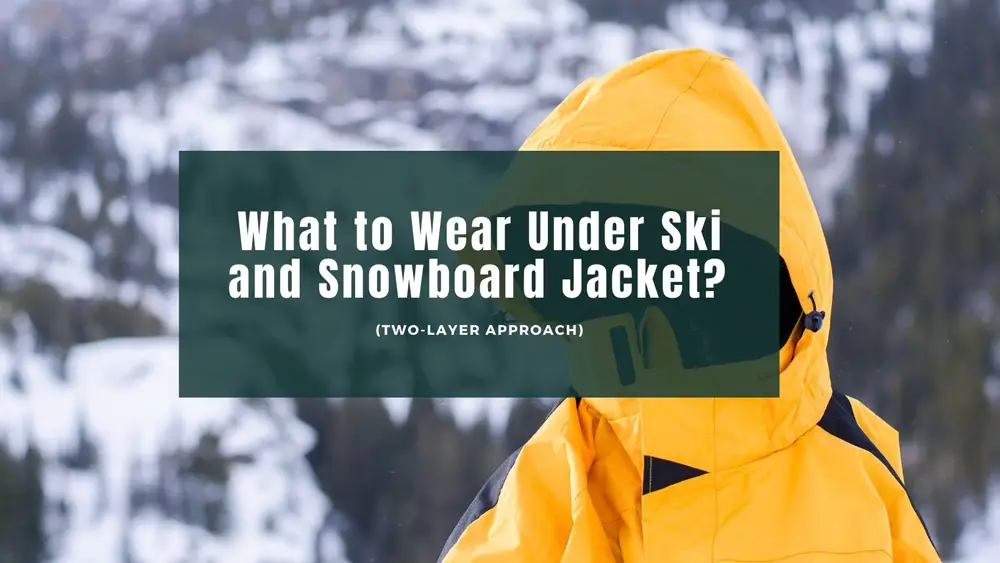One of the things that I notice whenever I see novice skiers and snowboarders is that they don’t have the proper attire. Some are even using non-specialized snow jackets, especially their first time. But aside from having the right jacket and the fitting pants, you also need to be particular about what you will wear underneath. And when it comes to selecting what to wear under a ski jacket, this can make a difference between feeling cold or staying warm.
Even if ski and snowboard jackets have a lining to keep the person warm, this isn’t enough to keep you comfortable. That’s the reason why you will need to know how to layer your clothes underneath your ski jacket.
What to Wear Under Ski and Snowboard Jacket?

When it comes to finding the right clothes underneath your ski shell, you have to worry about two things. One, it has to keep you warm. And secondly, you need to worry about its breathability or its ability to remove moisture or sweat.
These days, there are lots of options to choose from. I recommended a two-layer approach: a base layer and a mid-layer to wear under your ski and snowboard jacket to keep you warm and dry on the mountain. With this layered jacket system, you can regulate and control your temperature as it changes throughout the day.
Ski Base Layer
A base layer will be the first line of defense against the cold. This is usually tight-fitting and made out of synthetic materials that are designed to wick sweat off your skin. Nowadays, the best examples of a base layer are made out of synthetic materials such as merino wool, acrylic, and polyester. These fabrics trap heat within their structure so they can maintain warmth even when wet through with sweat during intense physical activity.
Why is it important to keep yourself dry when skiing? Sweat can soak your clothes and can easily make you feel cold. Good base layers for skiing are those that are tight-fitting and lightweight.
Ski Mid-Layer
From the base layer, you will also have to think of wearing a mid-layer. Just like your base layer, mid-layers are often breathable and designed to provide further insulate heat. The purpose of having a mid-layer is to have additional clothing that can keep body temperature that the base layer failed to retain. Plus, it also helps stop cold air from reaching your skin.
For mid-layer clothing, it’s common to see people wear fleece jackets and softshell jackets. Depending on the temperature you will have to deal with, thicker fleece is suited for cold temperatures.
How to Choose Ski Base & Mid-Layers?

A glance at ski and snowboarding stores, you’d most likely see that there are lots of base and mid-layer options to choose from. And at times, it can get too overwhelming. To narrow down your options when selecting a base or a mid-layer, here are a few things you might want to check.
Weight
First, you want to consider the weight. The heavier the clothing, the harder it is to move around. Keep in mind that there’s a reason why skiing comes with tight-fitting jackets. That’s because it is designed to lessen the drag allowing the person to ski at full speed. More weight means that it can slow you down.
However, if you’re dealing with extremely cold temperatures, it is sometimes ideal to go for the thicker base and mid-layers. Lightweight base and mid-layers are typically used during summer.
If you’re going to buy a base layer or a mid-layer, be sure to check the how fabric’s weight per square meter (GSM). Merino wool usually weighs around 150 gsm, making it a great choice even for the summer.
Materials
For the base layer, there are two popular materials that you can go for. The first is merino wool. Merino wool came from the merino sheep. The biggest advantage of merino wool material is that it is quick-drying; it gets to insulate body heat even if it gets a bit wet. Plus, it is also soft to touch, making it comfortable to wear.
So it’s a wool material. Does it mean that it’s itchy? Not necessarily. Merino sheep produce ultra-fine and soft wool that isn’t itchy to the human skin. It is even softer than most synthetic materials that you will see in the market. It is comparable to your cotton t-shirt.
Since merino wool is a bit expensive, a lot of skiing and snowboarding enthusiasts choose synthetic materials over merino wool. Synthetic base and mid-layers typically have moisture-wicking properties keeping you warm and dry without making you spend a good amount of money in the process. On top of this, synthetic material tends to get dry faster than merino wool. And because of this, some people prefer this over merino wool especially in situations where you have to sweat a lot. The biggest downside of synthetic materials is that it doesn’t will tend to smell after a while.
Types
There are different types of base and mid-layers to choose from. As for the base layer, these are either long-sleeved thermals or merino wool clothes. As for the bottoms, it’s usually a choice between Long Johns or thermals.
For mid-layers, you can go with a full-zip mid-layer jacket. This type of mid-layer allows you to remove the ski or snowboard jacket indoors. Most full-zip mid-layer jackets are made of synthetic materials.
Then, you have the puffy mid-layers that are known for being lightweight. These types of mid-layers can be folded into a small bag allowing you to have more room for other things in your bag.
Next, you also have the fleece jackets. Fleece jackets are known for their breathability, warmth, and comfort. Unfortunately, fleece jackets are not space savers in your luggage.
Then, there are also vest-type jackets. These are mid-layers that provide better ventilation than the other mid-layers that you see in the market.
Sustainability
Some environmentally conscious buyers go for products that can help the environment. That’s where sustainable mid-layer jackets come in handy. These are made of recycled materials. The likes of PrimaLoft Eco insulation material are a popular choice among environmentally conscious consumers. This type of fabric is made of 50% recycled materials.
Also, merino wool is organic and biodegradable. However, it isn’t always the most “sustainable” choice. Raising sheep can also have its disadvantages. It is known to cause the cutting down of trees to make room for farms. Consequently, it can lead to erosion and can negatively affect overall biodiversity.
Final Thoughts
Knowing what to wear underneath your ski or snowboard jacket can make the snow sport enjoyable. The good news is that there are lots of options in the market. However, it sometimes boils down to your personal preference, budget, and the condition you will be exposed to. Try to do a lot of research first before you decide to go for a base layer and a mid-layer. This way, you can stay dry and warm while doing the activity.


